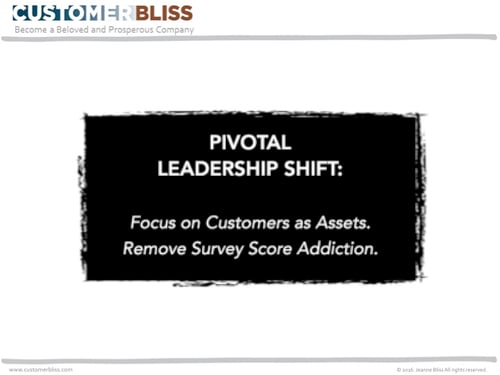Honoring the principle “customers as assets” connects volume and value to customer experience ROI and growth.
The goal of the chief customer officer (CCO) is to unite the leadership team in delivering one-company customer experiences and connecting the delivery to business growth. This will require the removal of survey score addiction and a shift in leadership thinking.
The pivotal leadership shift occurs when you simplify the why behind this work so that leadership can stand behind it and communicate as their own. Here are four elements to grow customer experience ROI.
1. Elevate customers as assets.
The principle of treating your customers as assets requires measuring the impact of the end-to-end customer experience. It measures what customers actually did (through their behaviors), versus what they say they are going to do (via surveys).
Measuring customers as assets illuminates how customers voted with their feet to:
- Stay or leave
- Get more or less from you
- Bring others to you
Most important, “customers as assets” shifts the conversation from achieving sales or a survey score to caring about why customer behavior changed as a result of their journey with you.
Your opportunity is to gain leadership’s attention to this simple definition of success. Create a desire for leaders to care about knowing and managing customer asset performance with the same rigor that’s applied to sales, revenue, and EBITA performance.
2. Shift success metrics to growth or loss of the customer asset.
I can’t emphasize enough the importance of the attitudinal shift you must achieve with leaders in how leaders communicate the success of the business. Leaders must become fearless enough to start meetings by connecting the efforts of the entire organization to the growth or loss of this asset.
What would change in your company if every executive meeting included a structure similar to this?
- Start with the question “did we earn the right to customer growth?”
- Move to specifics.
- By segment of your customer base, how many new customers were acquired, in whole numbers—volume and value?
- By segment of your customer base, how many customers did we lose, in whole numbers—volume?
- Ask “why?” (This is the most important step.)
- What did we do to grow or shrink this asset?
- Across the entire operation, not just in sales or service, but also as a result of the overall experience?
Customer asset metrics, which track what customers actually did versus what they say they might do, drive action on their simplicity. You either keep customers and grow customer experience ROI or you lose customers and must care to learn why.
Did we all together, earn the right to growth? Caring about that will change your leaders’ behaviors. It will help you transform the business.
3. Remove survey score addiction.

When executives talk about commitment to customer experience, they typically connect it primarily to survey score results.
In the absence of other simple ways to measure progress, such as tracking customer asset growth or loss, the survey score is the one quantifiable measure of success. Getting good scores leads conversations rather than discussing customers’ lives.
The end game becomes the score. So embedded is this addiction, that many clients tell me that sending the survey, waiting for results and trying to get "lift" on the score is their complete customer strategy.
Surveys do have an important place in this work. They are part of the information provided in the customer experience framework that gives a balanced story of customer’s lives. This balance enables leaders and the organization to:
- Step through the customer journey regularly, not only numerically, but also experientially.
- Involves the company in understanding how company actions or lack of action impacted customer experiences. (This information drives future behaviors, which grow or impede customer growth.)
4. Diminish the "leap of faith" approach in CX.
Using survey scores alone to quantify and drive action puts this work (and your role) in the “leap of faith” category. The connection between improved scores and improved growth is not always clear. That means "customer focus" is one of the top agenda items of the organization, but it’s not easily quantified. So leaders take a leap of faith to do the work because it’s the right thing to do.
You can stop the "leap of faith" by taking these actions:
- Engage leaders to elevate customers as the asset of your business.
- Create clarity that your role is to work with them to unite the organization in growing this asset.
How to start growing your customer experience ROI
It’s a lot different than looking at survey scores and discussing how to get "lift" without talking about customers’ lives, isn’t it? And that’s the power of elevating and honoring customers as assets. It lays the groundwork to enable the work because it connects it to ROI and growth. It unites leaders.
Embracing customers as assets shifts the attitude of leaders and, ultimately, the organization. The purpose of customer experience ROI is to earn the right to growth by improving the life of customers. When you improve the life, the score will follow. It will. But the shift is to start the work with the customer life, not the score. And that is no small shift.
A version of this article first appeared on customerbliss.com.








